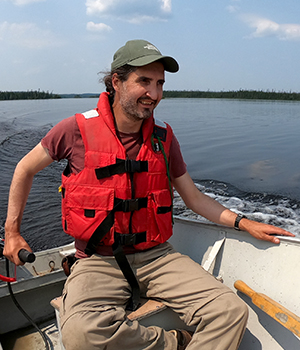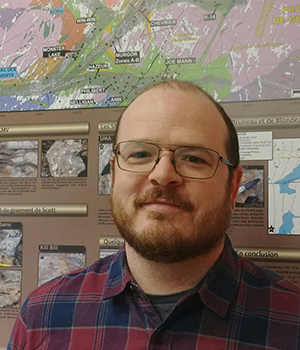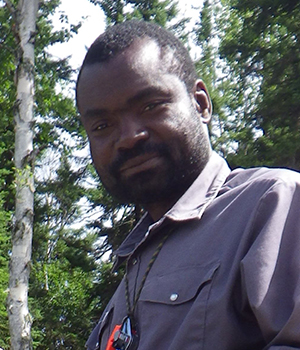The Grenville province and its complex geology offers a wide variety of mineralization styles. This session offers the opportunity to gather and discuss the major formation models of this highly potential province, rich in metals, industrial minerals and architectural stones. The session aims at presenting the new results and advances of Géologie Québec as well as university and industry partners. The most recent results of the mapping campaign carried in the Grenville in summer 2023 will also be presented.
Geology and Metallogeny of the Grenville Province: Mapping, Models and Exploration Advances
Tuesday, November 19, 2024
Room 403


After arriving in Quebec in 1967, Maurice Rive spent ten years mapping the western part of the Grenville Province for the Quebec ministère des Ressources naturelles.
Appointed resident geologist shortly after the publication of his report on the Sainte-Véronique area, Maurice Rive was put in charge of the Rouyn-Noranda regional office. This geological expert became the main contact for prospectors active in the Abitibi greenstone belt.
At the time, he was involved in promotional activities that culminated in the organization of the CIM symposium entitled La ceinture polymétallique du Nord-Ouest québécois (The polymetallic belt of North-West Quebec). The lectures given at this conference to over 400 people in Rouyn-Noranda were published in the form of a prestigious 423-page reference document much appreciated by exploration geologists.
In 1990, Maurice Rive's professional achievements earned him the promotion prize awarded at the Séminaire d'information sur la recherche géologique.
After a number of years with the Sherbrooke Mines regional office, Maurice Rive retired in 1997. Until the end of his long life, he was still working on a geological map straddling the boundary between the Abitibi greenstone belt and the Grenville Province. It is in recognition of his work and as a tribute to his extraordinary tenacity that this session is dedicated to him today.
1:45 p.m.
Tectonic Environment of Emplacement of Proterozoic-Age Massif-Type Anorthosites in the Eastern Canadian Shield

Consultant in geosciences
Massif-type anorthosites occur worldwide and were predominantly formed during the Paleo- to Mesoproterozoic Era, with an exceptionally large number emplaced in southeastern Laurentia, both within the Grenville Province and in the foreland of the Southeastern Churchill Province and North Atlantic Craton (Nain Province). Their secular nature infers that physical and chemical conditions necessary for their formation were optimized during that time period. A review of geochronological and ambient tectonic regimes that were operating during their emplacement suggests that they formed during four periods, ca. 1.65 Ga, ca. 1.45-1.30 Ga, ca. 1.16-1.14 Ga, and 1.08-1.02 Ga. The first two pulses overlap with continent-ocean convergence and subduction beneath the SE Laurentian margin. The last two pulses correlate with continent-continent collisional tectonics. We argue that higher mantle temperatures during the Proterozoic, as inferred in published models, were not sufficient, by themselves, to produce the necessary volume of basaltic underplate—a key factor in the generation of massif-type anorthosites—and that mantle re-fertilization through metasomatism and/or lateral accretion of oceanic lithosphere might have played a key role. High geothermal gradients acquired during the 2.0-1.2 Ga accretionary and continental arc phase may have helped sustain abnormally high temperatures during the 1.2-1.0 Ga collisional phase of the Grenville Province.
2:15 p.m.
The Metamorphic Evolution of the Grenville Province: A Neglected Facet of the Formation of Some Critical and Strategic Mineral Deposits
The Grenville Province is the focus of growing interest in the exploration of critical and strategic minerals, even though its lithological, structural and metamorphic complexity has long limited the exploration of mineral resources. Since many types of mineralization are controlled by metamorphic processes or by tectonic and magmatic contexts, it is crucial to properly characterize these aspects of the evolution of this geological province in order to improve discovery opportunities. In situ petrochronology on monazite, xenotime and garnet is helping to better constrain the temporal evolution of burial, cooling and exhumation episodes. Ongoing projects at the INRS aim to characterize the metamorphic evolution of the central Grenville Province in order to better understand the tectonic framework associated with rare earth element (REE) and graphite mineralization in this sector.
REE-rich granitic pegmatites and alkaline intrusive suites were emplaced in the Haute-Mauricie region between 1060 Ma and 970 Ma and 1040 Ma and 980 Ma, respectively. Our preliminary results indicate that the metasedimentary rocks of the Wabash Complex, which partly host these intrusions, were buried, metamorphosed and deformed from the upper amphibolite facies to that of the granulites just before and at the beginning of the emplacement of the REE pegmatites. This is compatible with a crustal thickening model followed by the anatexis episode that gave rise to these mineralizations. Locally, monazite crystallization implies that prograde metamorphism began around 1150 Ma. Some samples show evidence of late garnet overgrowth at approximately 1000 Ma, while others indicate garnet destabilization during this period. This implies heterogeneous metamorphic conditions during the Rigolet Orogeny in Haute-Mauricie. These results are similar to those obtained in the Mauricie region, although cooling and exhumation seem to have started earlier in the latter.
Another project targets the Matawinie, La Loutre and Miller graphite deposits. Field and petrographic observations indicate that the mineralization at Matawinie is related to several metamorphic events that affected the Morin Terrane west of the Mauricie region. The current project will study the impact of the conditions, the number of metamorphic and anatectic episodes, and the duration of these events on the formation of flake graphite. To gain a deeper understanding of the genesis of certain types of mineralization in the Grenville Province, the characterization of metamorphic processes must be integrated with the interpretation of the tectonic context.
2:40 p.m.
Geology of the Kegaska Area, Grenville Province, North Shore, Quebec, Canada

MRNF
Co-author: Isabelle Lafrance (MRNF)
The 2023 field campaign involved mapping the Kegaska region at scale 1:50,000 (NTS sheet 12K03 and the southern border of sheet 12K06). A new lithodemic subdivision of the coastal region between the Kegaska River to the west and the Muquanousse River to the east is presented. With the exception of a kilometre-long band of metasedimentary rocks from the Coude Complex, a majority of intermediate to felsic plutonic rocks outcrop in this sector.
The oldest unit, the Kegaska Intrusive Suite, outcrops mainly to the SW and consists of foliated, medium-grained and commonly porphyroid quartz monzodiorite, granodiorite and monzogranite. This unit is locally cut by the Muddy Granodiorite and is bordered to the NE by the Grozieux Intrusion, which is composed of moderately to strongly foliated augen quartz syenite. The proportions of these units decrease in the eastern quarter of the map in favour of hypersthene syenite from the Mantuh Intrusive Suite, which is injected by the intermediate to felsic, slightly deformed, leucocratic intrusive rocks of the Muquanousse Intrusive Suite. These units are cut by monzonite, syenite and syenogranite forming the Washicoutai Intrusive Suite, which also includes the Rocher Rouge and Parsons intrusions.
Three major NW-SE to E-W ductile deformation zones, ranging from several hundred metres to several kilometres in width, cut across the area. The Musquaro River runs along the easternmost of these deformation zones. This delineates the Musquaro Gabbroic Intrusion and separates an eastern domain characterized by the common presence of orthopyroxene and by a dome and basin structure, from a western domain displaying planar fabrics with an almost unidirectional vergence to the south or SE. From an economic point of view, certain phases of the Washicoutai Intrusive Suite, including the Rocher Rouge Intrusion, are of interest for rare earth element mineralization. The potential of the Musquaro Gabbroic Intrusion for platinoid and Fe-Ti ± V ± P mineralization also remains to be clarified.
3:00 p.m.
The Bégin-Lamarche Apatite Deposit, Lac Saint-Jean Anorthositic Suite, Grenville Province: Geological Summary and Exploration Results

Laurentia Exploration
The Bégin-Lamarche apatite deposit is located ~40 km NNW of the city of Saguenay (Quebec), in the Bégin municipality. It was discovered in 2021 by local prospectors. The property was subsequently acquired by First Phosphate in 2022. Since then, 30,647 m of diamond drilling has been carried out on the property, and a bulk sample has been metallurgically assayed to determine the purity of the apatite for use in the manufacture of purified phosphoric acid (H3PO4) for LFP (lithium-iron-phosphorus) batteries.
The Bégin-Lamarche apatite deposit is located in the heart of the Lac-Saint-Jean Anorthositic Suite, in the Grenville Province. It extends for approximately 2.5 km along a NNE-SSW axis and is composed of several apatite-rich layers, giving it a projected surface thickness of up to 400 m. The deposit has been subdivided into 3 main zones (from south to north): the Southern Zone, the Northern Zone and the Mountain Zone. The best intersections are found in the Northern and Mountain Zones, grading more than 10% P2O5 over lengths reaching 99 m. As announced on September 18, 2024, inferred resources for the 3 zones combined are 214 Mt at 6.01% P2O5, including 162.9 Mt at 5.63% P2O5 in the Southern Zone, 44.3 Mt at 6.98% P2O5 in the Northern Zone and 6.8 Mt at 8.57% P2O5 in the Mountain Zone. In addition, the deposit contains indicated resources of 41.5 Mt at 6.49% P2O5 in the Northern and Mountain zones combined.
Apatite is associated with iron-titanium oxides (magnetite and ilmenite), but also with olivine and/or orthopyroxene. It is found in 2 main lithologies, oxide-apatite peridotite and oxide-apatite norite/orthopyroxenite, which are hosted in plagioclase-rich rocks (anorthosite, leuconorite and troctolite). Apatite is locally massive and occurs as metric layers of apatitolite grading up to 30.73% P2O5 over 2.15 m (Mountain Zone). These apatite rocks also contain clinopyroxene, amphibole, biotite, chlorite and hercynite in accessory quantities.
3:20 p.m.
Mapping and Exploration in the Lac-Saint-Jean Anorthositic Suite Using Mineral Chemistry by Portable XRF, a Small Revolution
The spatial distribution of the anorthositic facies in the anorthositic suites of the Grenville Province must be determined in order to gain a deeper understanding of the internal structure of these complex multiphase geological entities, such as the Lac-Saint-Jean Anorthositic Suite, which can total more than 20,000 km2 in surface area. An additionnal layer of information can be obtained by mapping the distribution of the chemical composition of dominant minerals in these complexes, as a complement to traditional field mapping. This is proving highly valuable in understanding and exploring these intrusions, which are potentially rich in Fe-Ti-V-P and even Ni-Cu.
The composition of the plagioclase (anorthite content, An) in the anorthosites generally varies from labradorite (An50-70) to andesine (An30-50) and can be used to map and identify the different lobes of these suites. In these intrusions, Fe-Ti-P deposits are generally associated with lobes composed of andesine-type plagioclase, whereas Fe-Ti-V deposits are associated with labradorite-type plagioclase.
The development of a new portable X-ray fluorescence (pXRF) analysis method at UQAC now makes it possible to measure in situ the calcicity and strontium concentration of plagioclase, and more recently even Mg# of olivine and pyroxenes, directly on a rock slice. The calcicity of plagioclase is traditionally calculated using molar Ca/(Ca+Na). Because of its low atomic weight, it is difficult to obtain Na readings by pXRF. However, based on the concept of double substitution (Ca-Na, Si-Al) in plagioclase, our work has developed an accurate substitute for calcicity using the Ca/Si ratio measured by pXRF. This method enables rapid, accurate and very inexpensive analyses to be carried out with minimal preparation in a field laboratory on grains >3 mm in diameter. This mineralogical mapping can be used as a day-to-day ‘field’ mapping tool to guide and/or confirm traditional exploration and mapping.
Several examples combining regional mapping with pXRF mapping of plagioclase composition will be presented for different sectors of the Lac-Saint-Jean Anorthositic Suite. We will show that the calcicity of the plagioclase, associated with the Sr content, allows for the identification of different lobes of distinct ages and chemistries within the same suite. These examples demonstrate the potential of this new mapping tool in the Grenville anorthositic complexes and its usefulness in identifying anorthositic lobes and areas favourable to mineralization in these intrusions.
3:40 p.m.
Geology of the Jalobert Lake Area, Grenville Province, Saguenay–Lac-Saint-Jean Area, Quebec, Canada
The Jalobert Lake area (NTS sheets 22D10 and 22D15) is part of the Allochton of the Grenville Province. This area was the subject of a 1:50,000 scale geological survey during the summer of 2023.
The crystalline basement of the area is formed by the Saguenay Gneissic Complex (1506 ±13 Ma) consisting of biotite-garnet-sillimanite-cordierite paragneiss, garnet-cordierite quartzite and calc-silicate rocks. These rocks, derived from a tonalitic upper crust, are found in klippes in the Cap à l'Est Gneissic Complex (1391 +8/-7 Ma) which has a calc-alkaline to shoshonitic affinity and occupies the SE part of sheet 22D10. These two units are injected by numerous intrusions and cut by granitic to syenitic pegmatite dykes.
The mapped area is occupied by a large volume of mafic to ultramafic rocks, including the Lac-Saint-Jean Anorthositic Suite (LSJAS, 1169 to 1135 Ma), the Vanel Anorthosite (VA, 1080 ±2 Ma) and the Mattawa Anorthosite (MA, 1016 ±2 Ma). The LSJAS covers a large part of sheets 22D10 and 22D15, the VA in the centre and north of 22D15, and the MA to the north-east of 22D15. The VA is calc-alkaline containing crystals of pink plagioclase, mainly labradorite. The LSJAS (3.28 < [La/Yb]N < 191.94) and the MA (10.90 < [La/Yb]N < 123.24) are tholeiitic to calc-alkaline. They are characterized by megaporphyroclasts of purplish plagioclase with an andesine to labradorite composition which, once recrystallized, take on a whitish hue as the grain size decreases (millimetric crystals).
Units of felsic to intermediate composition include the Chicoutimi Mangerite (1082 ±3 Ma) southwest of 22D10, the Poulin-de-Courval Mangerite (1068 ±3 Ma) east of 22D15, the La Baie Granite (1067 ±4 Ma) south of 22D10 and the La Hache Mangerite (1010 ±3 Ma). The Chicoutimi Mangerite (23.08 < [La/Yb]N < 111.40) is ferriferous and belongs to the shoshonitic series, while the Poulin-de-Courval (10.24 < [La/Yb]N < 170.61) and La Hache (9.79 < [La/Yb]N < 63.53) mangerites are calc-alkaline, K-rich calc-alkaline and above all shoshonitic.
The rocks in the region have undergone several deformation phases and are cut by faults and shear zones, the most important of which is the Saint-Fulgence Shear Zone. This NE-SW trending shear zone forms the edge of the LSJAS and continues NE over more than 100 km. This structure greatly influences the regional structural grain, which is essentially NE-SW oriented, and controls the emplacement of several intrusions. The last phase of deformation is associated with the opening of the Saguenay Graben.
The regional metamorphism is in the granulite facies. Retrograde metamorphism can be observed in places, marked by the uralitization of orthopyroxene in the leuconorite of the LSJAS.
Fe-Ti-V oxides mineralizations have been discovered at the edge of the Lac-Saint-Jean Anorthositic Suite in sheet 22D10. A significant REE mineralized zone has also been identified in the alkali feldspar granite of the Cap à l'Est Gneissic Complex, at the contact with the metasedimentary rocks of the Saguenay Gneissic Complex, as well as in granitic pegmatite dykes to the east in sheet 22D10.
4:00 p.m.



